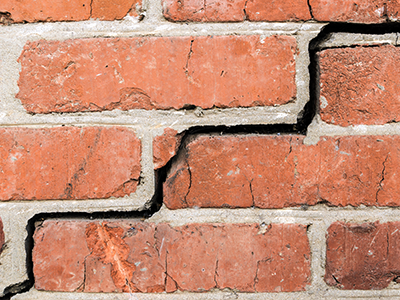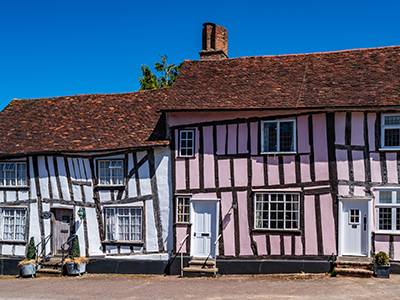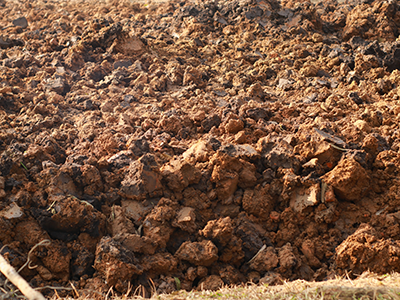Structural Movement in a House; what's normal?
- Structural movement in a house is common but can be a major issue if it goes beyond the superficial.
- A RICS surveyor will flag any visible signs of concerning movement in your house survey.
- If movement has been identified, you may require a structural engineer to investigate the extent of the problem and give an indication of the work required to fix it.
- You can still buy and sell a house with movement, but you should be prepared to negotiate.
What is structural movement?
There are many kinds of structural movement, including:
Subsidence: Subsidence is downward movement in the building foundations caused by the ground beneath it sinking.
Settlement: Settlement is the disruption or distortion of parts of the building due to shrinkage or unequal compression under its own weight.
Heave: Heave is a phenomenon where soil expands, pushing the ground under the house upwards. This tends to happen in clay soil where the ground swells when wet.
Sway: Sway is the movement of a building from side to side. Some very tall buildings are designed with some sway, to make them more resilient in high wind, it can allow sky-scrapers to move several feet in either direction without compromising their structural integrity. Non-sway structures are braced so they cannot sway. Most homes in the UK are non-sway structures. You do not want a building to sway unless it is designed to withstand the movement.
Bouncy floors: This is floor deflection and occurs when the floor joists are not big or close enough together to support overloaded floors.
Bulging walls: The walls can begin to bow vertically for a number of reasons, even including vibrations from heavy traffic. One danger here is that the floor space can widen, leaving the joists too short and making the floor unstable.
Cracks: Cracks can be caused by defective materials or any of the other types of movement. They are generally a symptom, but if they are severe enough, they can cause further movement in the building and may result in collapse.
Expansion: Expansion happens when materials used in the construction get bigger, often with temperature changes or damp levels, which can cause porous timbers to swell.
Contraction: Contraction happens when materials used in the construction get smaller, often with temperature changes or where 'green' wood loses moisture as it dries out, causing it to shrink.
Differential movement: Differential movement covers shrinkage, joint settlement, and deformation from loads which affect timber frames.



What causes structural movement in a house?
External factors
A perfectly constructed house will face issues with movement if the ground on which it is built moves. Movement in a house can also be caused by extreme wind, heat or ice, which may be more than the structure would 'normally' have to withstand. Moisture content in porous materials can expand when frozen, opening a wider channel. Over long periods, this can progress from small cracks appearing to chunks of masonry coming loose.
Ever wondered if you should buy a house with gable straps?
Can tree roots cause structural problems?
Large trees with deep roots can damage the existing foundations and weaken them by growing into gaps and cracks and causing ground movement. In some cases, you may have to cut the tree down, but you can help prevent this by keeping it well-pruned. This can be particularly problematic for old buildings, which were often built on simple shallow foundations.
Construction materials
If the materials used lack the adequate strength for their purpose, or are faulty, this can affect structural stability and cause movement. For example, if you use steel, you need a relatively small ridge beam. If you use timber which is not as strong, you'll need a much larger ridge beam to provide sufficient strength. If you were to replace a steel beam with a timber beam of the same size, it would not be strong enough to hold the building up and you would see dangerous structural damage fairly quickly.
Construction method
Building regulations ensure that new buildings meet required safety standards. If a building is not properly braced and tied together, it will move.
For example:
- Internal walls are not properly bonded to the external walls, where they meet.
- Masonry walls do not have adequate give for expansion and contraction or incorporate different materials which expand and contract at different rates and temperatures.
- Missing or failing lintels above doors and windows.
- The building was constructed in columns or two-dimensional panels, without cross bracing.
- The timbers, beams, joists or rafters are too small or too widely spaced to support the weight.
- The weight of the roof is not properly supported with heavy enough beams at floor and ceiling levels to tie the walls together. This is known as roof spread.
- Supporting structures have been cut through or weakened during structural alterations.
- Load-bearing structures such as chimney breasts have been removed without proper reinforcement.
Material decay
Timber can last a lifetime if well chosen and well looked after, but we've all seen wood rot or fall apart with woodworm. More 'permanent' materials are also more vulnerable to decay than you might think. The primary cause of decay is water, so where there is a leak or even poor ventilation causing an excess of condensation. Bricks, stone and old-fashioned mortar are vulnerable to prolonged exposure to moisture, especially during winter when ice will expand inside cracks and pores. Iron and steel, including steel-reinforced concrete, are vulnerable to rust.
How can I spot the signs of structural movement?
Cracks appearing is one of the most obvious signs of structural movement, but you should also look out for sticking doors or windows, bowing or bulging in the line of the walls, slanting or uneven floors, and nail heads or screws popping out through the paint.
External signs of structural movement include gappy window and door frames, walls leaning outwards, and cracked glazing or chimney structure.
It is hard to tell whether hairline cracks and leaking drains are from past movements that have since been rectified, in a single house viewing, which is why it's important to choose solicitors and surveyors who are well experienced in this type of investigative work.
How much movement in a house is normal?
Some movement is normal and has been designed into our homes forever. Long before structural engineers were calculating shrinkage, master joiners were building houses from green oak, knowing it would shrink and settle as it aged.
While cracks don't generally require serious structural intervention unless they exceed 25mm, they will need filling and may require repointing if they exceed 1mm. Cracks over 5mm will likely allow water in and can allow dampness into the building which will cause further damage. At 5-15mm of movement, pipes may fracture and some masonry may require repair. Beyond 15mm, you will see windows and doorframes becoming distorted, walls and floors sloping or leaning, and whole sections of walls may need to be replaced.
Minor structural movement is normal and shouldn't put you off of buying a home. If the issue is (or looks like it might be) extensive, then you're right to be questioning if the purchase is right for you. If you're willing to take on a bit of a project, you can proceed, with caution!
We recommend you always get a house survey when buying a home; your chartered surveyor will note any visible signs of structural movement and may recommend an intrusive inspection from a structural engineer if they believe further investigation is required.
You should not proceed with the purchase until the full extent of the issue has been discovered, as structural movement can cost anywhere from a couple of hundred pounds for a patch job to somewhere in the region of £40,000 to underpin the whole building.
Any estimated costs can be negotiated off the sale price, with support from your surveyor.
You may, however, still have a problem with your lender, as they are unlikely to grant you the mortgage funds if they aren't satisfied that the property is safe. If you are buying with a mortgage and the intention to remedy the problems after purchase, you should speak to a broker about what mortgage products may be suitable for you.
Structural movement doesn't mean you won't be able to sell your house, but you should be prepared that it will be a bit trickier. First and foremost: You must never lie or misrepresent the property to the seller. Trying to cover up any serious issues is misrepresentation, which can result in a big lawsuit.
You should keep a record of any builders' assessments, structural survey or engineer's reports that you have had, and be upfront with your buyer, who will understandably want the sale price to reflect the risk they're taking on, if they go ahead and buy. If the structural movement is superficial, they will need to carry out surveys of their own to satisfy themselves (and their lender) that there is no risk.
If the problem is significant and you're not willing to come down on the sale price, you may have to look into getting the issue fixed yourself.
Even if you do come down on price, you may be unable to sell to a buyer with a mortgage, as the mortgage lender is unlikely to grant the money unless they are satisfied that the property (and their investment) is safe. A cash buyer may be willing to take the risk, for the right price.
Your options are fairly simple: either get the problem fixed or be prepared to accept a lower sale price to reflect the higher risk of buying a house with structural movement.
Will my RICS Surveyor identify structural movement?
Your RICS Surveyor will identify visible signs of structural movement. If there are visible signs, they may consider the movement to be superficial, or they may recommend an intrusive survey, to resolve the concern. If the seller has covered up signs of structural movement by filling cracks or repointing masonry and redecorating to cover their tracks, then the surveyor may not be able to pick up on the issue.
If it is later discovered that the seller knew of the problem, hid it, and lied to you, you may be able to sue the seller for misrepresentation, to recover the losses you suffered as a result.
Do I need a structural engineer?
If you own the house, a trusted builder may be a less expensive first step for you to identify the extent of the problem, as they can carry out an intrusive inspection and repair any resulting damage as they go. If the problem is severe, a structural engineer may be required to properly assess how to make the building safe, particularly in cases of subsidence.
If you are buying a house, you should get a house survey as standard. Your RICS Surveyor will carry out a non-intrusive inspection and indicate whether they believe a structural engineer is necessary. In many cases, the structural movement is within a normal range and isn't an issue.
Caragh is an excellent writer and copy editor of books, news articles and editorials. She has written extensively for SAM for a variety of conveyancing, survey, property law and mortgage-related articles.
Andrew started his career in 2000 working within conveyancing solicitor firms and grew hands-on knowledge of a wide variety of conveyancing challenges and solutions. After helping in excess of 50,000 clients in his career, he uses all this experience within his article writing for SAM, mainstream media and his self published book How to Buy a House Without Killing Anyone.









